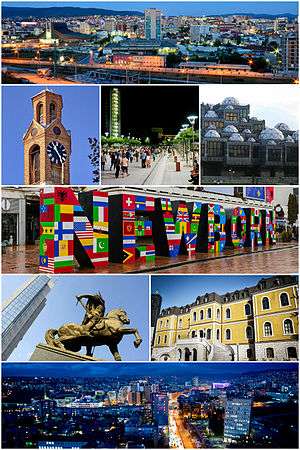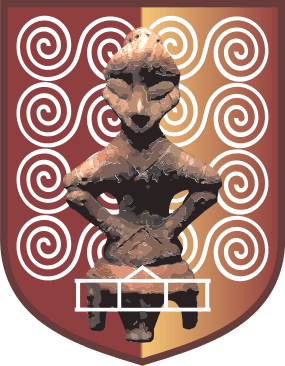Pristina
| Pristina Albanian: Prishtina / Prishtinë Serbian: Приштина / Priština | ||
|---|---|---|
| City and municipality | ||
| City of Pristina | ||
|
From top (left to right): a panoramic view of the city, clock-tower, Skanderbeg square, National Library of Kosovo, the Newborn monument (2013 repainting), the Kosovo Government Building and the Skanderbeg monument, National Museum of Kosovo and a view of Prishtina at night. | ||
| ||
 Pristina Location in Kosovo | ||
| Coordinates: 42°40′N 21°10′E / 42.667°N 21.167°E | ||
| Country | Kosovo[lower-alpha 1] | |
| District | District of Pristina | |
| Government | ||
| • Mayor | Shpend Ahmeti (VV) | |
| Area | ||
| • City and municipality | 572 km2 (221 sq mi) | |
| Elevation | 652 m (2,139 ft) | |
| Population (12–2013)[1] | ||
| • City and municipality | 211,129 | |
| • Density | 370/km2 (960/sq mi) | |
| • Urban[2] | 211,129 | |
| • Metro | 504,165 | |
| Time zone | CET (UTC+1) | |
| • Summer (DST) | CEST (UTC+2) | |
| Area code(s) | +381 38 | |
| Website | Municipality of Pristina (Albanian) | |
Pristina, also spelled Prishtina[3][4] (Albanian: Prishtinë, IPA: [pɾiʃtinə]) or Priština (Serbian Cyrillic: Приштина), is the capital and largest city of Kosovo.[lower-alpha 1] It is the administrative center of the homonymous municipality and district.
Preliminary results of the 2011 census put the population of Pristina at 198,000.[5] The city has a majority Albanian population, alongside other smaller communities. It is the administrative, educational, and cultural center of Kosovo. The city is home to the University of Pristina and is served by Pristina International Airport.
Name
The name of the city is derived from a Slavic form *Prišьčь, a possessive adjective from the personal name *Prišьkъ, (preserved in the Kajkavian surname Prišek, in the Old Polish personal name Parzyszek, and in the Polish surname Pryszczyk) and the derivational suffix -ina 'belonging to X and his kin'. The name is most likely a patronymic of the personal name *Prišь, preserved as a surname in Sorbian Priš, and Polish Przybysz, a hypocoristic of the Slavic personal name Pribyslavъ.[6] A false etymology connects the name Priština with the Serbian word prišt (пришт), meaning 'ulcer' or 'tumour', referring to its 'boiling'.[7] However, this explanation cannot be correct, as Slavic place names ending in -ina corresponding either or both to an adjective or the name of an inhabitant lacking this suffix are built from personal names or denote a person and never derive, in these conditions, from common nouns (SNOJ 2007: loc. cit.). The inhabitants of this city call themselves Prishtinali in local Gheg Albanian or Prištevci (Приштевци) in the local Serbian dialect.
Geography
Pristina is located at the geographical coordinates 42° 40' 0" North and 21° 10' 0" East and covers 572 square kilometres (221 sq mi). It lies in the north-eastern part of Kosovo close to the Goljak mountains. From Pristina there is a good view of the Šar Mountains which lie several kilometres away in the south of Kosovo. Pristina is located beside two large towns, Obilić and Kosovo Polje. In fact Pristina has grown so much these past years that it has connected with Kosovo Polje. Lake Badovac is just a few kilometres to the south of the city.
There is no river passing through the city of Pristina now but there was one that passed through the center. The river flows through underground tunnels and is let out into the surface when it passes the city. The reason for covering the river was because the river passed by the local market and everyone dumped their waste there. This caused an awful smell and the river had to be covered.
The river now only flows through Pristina's suburbs in the north and in the south.
Climate
Pristina has a humid continental climate (Dfb in the Köppen climate classification), with maritime influences. The city features warm summers and relatively cold, often snowy winters.
| Climate data for Pristina | |||||||||||||
|---|---|---|---|---|---|---|---|---|---|---|---|---|---|
| Month | Jan | Feb | Mar | Apr | May | Jun | Jul | Aug | Sep | Oct | Nov | Dec | Year |
| Record high °C (°F) | 15.8 (60.4) |
20.2 (68.4) |
26.0 (78.8) |
29.0 (84.2) |
32.3 (90.1) |
36.3 (97.3) |
39.2 (102.6) |
36.8 (98.2) |
34.4 (93.9) |
29.3 (84.7) |
22.0 (71.6) |
15.6 (60.1) |
39.2 (102.6) |
| Average high °C (°F) | 2.4 (36.3) |
5.5 (41.9) |
10.5 (50.9) |
15.7 (60.3) |
20.7 (69.3) |
23.9 (75) |
26.4 (79.5) |
26.7 (80.1) |
23.1 (73.6) |
17.1 (62.8) |
10.1 (50.2) |
4.1 (39.4) |
15.5 (59.9) |
| Daily mean °C (°F) | −1.3 (29.7) |
1.1 (34) |
5.0 (41) |
9.9 (49.8) |
14.7 (58.5) |
17.8 (64) |
19.7 (67.5) |
19.5 (67.1) |
15.9 (60.6) |
10.6 (51.1) |
5.1 (41.2) |
0.4 (32.7) |
9.8 (49.6) |
| Average low °C (°F) | −4.9 (23.2) |
−2.8 (27) |
0.2 (32.4) |
4.2 (39.6) |
8.5 (47.3) |
11.4 (52.5) |
12.5 (54.5) |
12.3 (54.1) |
9.4 (48.9) |
5.0 (41) |
0.9 (33.6) |
−3.1 (26.4) |
4.4 (39.9) |
| Record low °C (°F) | −27.2 (−17) |
−24.5 (−12.1) |
−14.2 (6.4) |
−5.3 (22.5) |
−1.8 (28.8) |
0.5 (32.9) |
3.9 (39) |
4.4 (39.9) |
−4.0 (24.8) |
−8.0 (17.6) |
−17.6 (0.3) |
−20.6 (−5.1) |
−27.2 (−17) |
| Average precipitation mm (inches) | 38.9 (1.531) |
36.1 (1.421) |
38.8 (1.528) |
48.8 (1.921) |
68.2 (2.685) |
60.3 (2.374) |
51.6 (2.031) |
44.0 (1.732) |
42.1 (1.657) |
45.4 (1.787) |
68.2 (2.685) |
55.5 (2.185) |
597.9 (23.539) |
| Average precipitation days (≥ 0.1 mm) | 13.6 | 12.3 | 11.4 | 12.1 | 12.8 | 11.9 | 8.3 | 7.9 | 7.5 | 8.6 | 12.3 | 14.5 | 133.2 |
| Average relative humidity (%) | 83 | 77 | 70 | 65 | 67 | 67 | 63 | 62 | 68 | 74 | 80 | 83 | 71 |
| Mean monthly sunshine hours | 70.8 | 96.0 | 143.0 | 184.0 | 227.9 | 246.3 | 299.3 | 289.6 | 225.8 | 173.5 | 96.9 | 70.2 | 2,123.3 |
| Source: Republic Hydrometeorological Service of Serbia[8] | |||||||||||||
Water
Pristina is one of the municipalities with the most severe water shortages in the country.[9] Citizens of Pristina have to cope with daily water curbs due to the lack of rainfall and snowfall which has left the city's water supplies in a dreadful condition.[9] The current water resources do not fulfil the needs of the overgrowing population of Pristina. The water supply comes from the two main reservoirs of Batllava and Badovci.[9] However, there are many problems with the water supply that comes from these two reservoirs which supply 92% of the population in Pristina.[10] As such, the authorities have increased their efforts to remedy the situation and to make sure that such crises do not hit the city again.[11]
History
Dardani Period 4th Century BC–2nd Century BC
Roman Republic/ Empire c. 168 BC–c. 330 AD
Byzantine Empire c. 330–c. 850
First Bulgarian Empire c. 850–c. 1018
Byzantine Empire c. 1018–1040
Peter Delyan's Bulgaria 1040–1041
Byzantine Empire 1041–1072
Constantine Bodin's Bulgaria 1072
Byzantine Empire 1072–1180
Serbian Grand Principality 1180–1217
![]() Second Bulgarian Empire 1218–c. 1241
Second Bulgarian Empire 1218–c. 1241
![]() Kingdom of Serbia c. 1241–1346
Kingdom of Serbia c. 1241–1346
![]() Serbian Empire c. 1346–1389
Serbian Empire c. 1346–1389
![]() Ottoman Empire 1389–1689
Ottoman Empire 1389–1689
![]() Holy Roman Empire 1689–1690
Holy Roman Empire 1689–1690
![]() Ottoman Empire 1690–1912
Ottoman Empire 1690–1912
![]() Kingdom of Serbia 1912–1915
Kingdom of Serbia 1912–1915
![]() Kingdom of Bulgaria 1915–1918
Kingdom of Bulgaria 1915–1918
![]() Kingdom of Serbia 1918
Kingdom of Serbia 1918
![]() Kingdom of Yugoslavia 1918–1941
Kingdom of Yugoslavia 1918–1941
![]() Albanian Kingdom (Kingdom of Italy) 1941–43
Albanian Kingdom (Kingdom of Italy) 1941–43
![]() Albanian Kingdom (Nazi Germany) 1943–44
Albanian Kingdom (Nazi Germany) 1943–44
![]() NKOJ 1944–45
NKOJ 1944–45
![]() SFR Yugoslavia 1945–1992
SFR Yugoslavia 1945–1992
![]() FR Yugoslavia 1992–1999
FR Yugoslavia 1992–1999
![]() UNMIK 1999–2008
UNMIK 1999–2008
![]() Republic of Kosovo 2008–present
Republic of Kosovo 2008–present
Early history
The area in and around Pristina has been inhabited for nearly 10,000 years.[12] Early Neolithic findings were discovered dating as far back as the 8th century BC, in the areas surrounding Pristina, i.e.: Matiçan, Gračanica and Ulpiana.[12][13] In the 4th century BC, Bardyllis brought various tribes together in the region, establishing the Dardanian Kingdom.[14][15][16] After the Roman conquest of Illyria in 168 BC, Romans colonized and founded several cities in the region, which they named Dardania.[17]
During the Roman period, Pristina was part of the province of Dardania and Ulpiana was considered one of the most important Roman cities in the Balkans. In the 2nd century AD, Ulpiana became a Roman municipium. The city suffered tremendous damage from an earthquake in AD 518.[18] The Byzantine Emperor Justinian I decided to rebuild the city in great splendor and renamed it Justiniana Secunda but with the arrival of Slav tribes in the 6th century the city again fell into disrepair.[18]
Medieval period
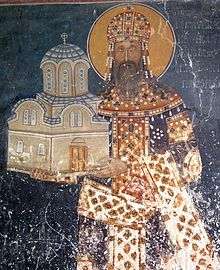
In Serbian Archbishop Sava's Life of Saint Simeon, written between 1201 and 1208, the župe (counties) of Sitnica and Lipljan are mentioned, which had territory around present-day Pristina. Pristina was an important town in Medieval Serbia, having been a royal estate of Stefan Milutin, Stefan Uroš III, Stefan Dušan, Stefan Uroš V and Vuk Branković.[19][20] The medieval fort of Višegrad, whose ruins lie three kilometres east of the city centre, was mentioned in Milutin's time,[21] and served as his capital,[22] and the nearby Gračanica monastery was founded by him in ca. 1315.
The first historical record mentioning Pristina by its name dates back to 1342 when the Byzantine Emperor John VI Kantakouzenos described Pristina as a 'village'.[12] In the course of the 14th and 15th centuries, Pristina developed as an important mining and trading center thanks to its proximity to the rich mining town of Novo Brdo, and due to its position of the Balkan trade routes. The old town stretching out between the Vellusha and Prishtevka rivers which are both covered over today, became an important crafts and trade center. Pristina was famous for its annual trade fairs (Panair)[12] and its goat hide and goat hair articles. Around 50 different crafts were practiced from tanning to leather dying, belt making and silk weaving, as well as crafts related to the military – armorers, smiths, and saddle makers. As early as 1485, Pristina artisans also started producing gunpowder. Trade was thriving and there was a growing colony of Ragusan traders (from modern day Dubrovnik) providing the link between Pristina's craftsmen and the outside world.[12] The first mosque was constructed in the late 14th century while still under Serbian rule.[12] The 1487 defter recorded 412 Christian and 94 Muslim households in Pristina, which at the time was administratively part of the Sanjak of Vučitrn.
Initial Ottoman period
In the early Ottoman era, Islam was an urban phenomenon and only spread slowly with increasing urbanization. The travel writer Evliya Celebi, visiting Pristina in the 1660s was impressed with its fine gardens and vineyards.[12] In those years, Pristina was part of the Vıçıtırın Sanjak and its 2,000 families enjoyed the peace and stability of the Ottoman era. Economic life was controlled by the guild system (esnafs) with the tanners' and bakers' guild controlling prices, limiting unfair competition and acting as banks for their members. Religious life was dominated by religious charitable organizations often building mosques or fountains and providing charity to the poor.
Austrian-Turkish War
During the Austrian-Turkish War in the late 17th century, Pristina citizens under the leadership of the Catholic Albanian priest Pjetër Bogdani pledged loyalty to the Austrian army and supplied troops. He contributed a force of 6,000 Albanian soldiers to the Austrian army which had arrived in Pristina. Under Austrian occupation, the Fatih Mosque (Mbretit Mosque) was briefly converted to a Jesuit church.[12]
Following the Austrian defeat in January 1690, Pristina's inhabitants were left at the mercy of Ottoman and Tatar troops who took revenge against the local population as punishment for their co-operation with the Austrians. A French officer traveling to Pristina noted soon afterwards that "Pristina looked impressive from a distance but close up it is a mass of muddy streets and houses made of earth".[12]
Declining Ottoman era and Balkan War
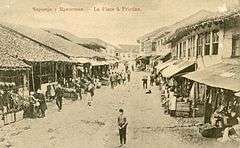
The year 1874 marked a turning point. That year the railway between Salonika and Mitrovica started operations and the seat of the vilayet of Prizren was relocated to Pristina. This privileged position as capital of the Ottoman vilayet lasted only for a short while. from January until August 1912, Pristina was liberated from Ottoman rule by Albanian rebel forces led by Hasan Prishtina.[23] However, The Kingdom of Serbia opposed the plan for a Greater Albania, preferring a partition of the European territory of the Ottoman Empire among the four Balkan allies.[24] On October 22, 1912, Serb forces took Pristina. However, Bulgaria, dissatisfied with its share of the first Balkan War, occupied Kosovo in 1915 and took Pristina under Bulgarian occupation.[25] In late October 1918, the 11th French colonial division took over Pristina and returned Pristina back to what then became the 'First Yugoslavia' on the 1st of December 1918.[25] In September 1920, the decree of the colonization of the new southern lands' facilitated the takeover by Serb colonists of large Ottoman estates in Pristina and land seized from Albanians.[25] The interwar period saw the first exodus of Albanian and Turkish speaking population.[12][25] From 1929 to 1941, Priština was part of the Vardar Banovina of the Kingdom of Yugoslavia.
World War II

On 17 April 1941, Yugoslavia surrendered unconditionally to axis forces. On 29 June, Benito Mussolini proclaimed a greater Albania, with most of Kosovo under Italian occupation united with Albania. There ensued mass killings of Serbs, in particular colonists, and an exodus of tens of thousands of Serbs.[26][27] After the capitulation of Italy, Nazi Germany took control of the city. In May 1944, 281 local Jews were arrested by units of the 21st Waffen Mountain Division of the SS Skanderbeg (1st Albanian), which was made up mostly of Muslim Albanians. The Jews were later deported to Germany, where many were killed.[28][29] The few surviving Jewish families in Pristina eventually left for Israel in 1949.[12] As a result of World War II and forced migration, Pristina's population dropped to 9,631 inhabitants.[12]
Pristina after World War II

The communist decision to make Pristina the capital of Kosovo in 1947 ushered a period of rapid development and outright destruction. The Yugoslav communist slogan at the time was uništi stari graditi novi (destroy the old, build the new). In a misguided effort to modernize the town, communists set out to destroy the Ottoman bazaar and large parts of the historic center, including mosques, catholic churches and Ottoman houses.[12] A second agreement signed between Yugoslavia and Turkey in 1953 led to the exodus of several hundreds more Albanian families from Pristina. They left behind their homes, properties and businesses.[12] However, this policy changed under the new constitution ratified in 1974. Few of the Ottoman town houses survived the communists' modernization drive, with the exception of those that were nationalized like today's Emin Gjiku Museum or the building of the Institute for the Protection of Monuments.
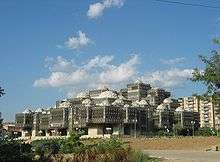
As capital city and seat of the government, Pristina creamed off a large share of Yugoslav development funds channeled into Kosovo. As a result, the city's population and its economy changed rapidly. In 1966, Pristina had few paved roads, the old town houses had running water and Cholera was still a problem. Prizren continued to be the largest town in Kosovo. Massive investments in state institutions like the newly founded University of Pristina, the construction of new high-rise socialist apartment blocks and a new industrial zone on the outskirts of Pristina attracted large number of internal migrants. This ended a long period when the institution had been run as an outpost of Belgrade University and gave a major boost to Albanian-language education and culture in Kosovo. The Albanians were also allowed to use the Albanian flag.
Within a decade, Pristina nearly doubled its population from about 69,514 in 1971 to 109,208 in 1981.[12] This golden age of externally financed rapid growth was cut short by Yugoslavia's economic collapse and the 1981 student revolts. Pristina, like the rest of Kosovo slid into a deepening economic and social crisis. The year 1989 saw the revocation of Kosovo's autonomy under Milošević, the rise of Serb nationalism and mass dismissal of ethnic Albanians.[12]
Pristina in the Kosovo War and afterwards
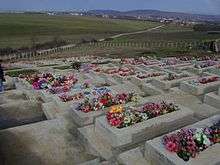
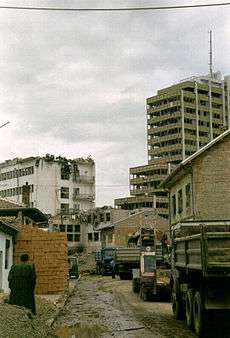
Following the reduction of Kosovo's autonomy by Serbian President Slobodan Milošević in 1989, a harshly repressive regime was imposed throughout Kosovo by the Yugoslav government with Albanians largely being purged from state industries and institutions.[12] The LDK's role meant, that when the Kosovo Liberation Army began to attack Serbian and Yugoslav forces from 1996 onwards, Pristina remained largely calm until the outbreak of the Kosovo War in March 1999. Pristina was spared large scale destruction compared to towns like Gjakova or Peć that suffered heavily at the hands of Serbian forces. For their strategic importance, however, a number of military targets were hit in Pristina during NATO's aerial campaign, including the post office, police headquarters and army barracks (today's Adem Jashari garrison on the road to Kosovo Polje).
Widespread violence broke out in Pristina. Serbian and Yugoslav forces shelled several districts and, in conjunction with paramilitaries, conducted large-scale expulsions of ethnic Albanians accompanied by widespread looting and destruction of Albanian properties. Many of those expelled were directed onto trains apparently brought to Pristina's main station for the express purpose of deporting them to the border of the Republic of Macedonia, where they were forced into exile.[30]
On, or about, 1 April 1999, Serbian police went to the homes of Kosovo Albanians in the city of Pristina/Prishtinë and forced the residents to leave in a matter of minutes. During the course of Operation Horseshoe, a number of people were killed. Many of those forced from their homes went directly to the train station, while others sought shelter in nearby neighbourhoods. Hundreds of ethnic Albanians, guided by Serb police at all the intersections, gathered at the train station and then were loaded onto overcrowded trains or buses after a long wait where no food or water was provided. Those on the trains went as far as Đeneral Janković, a village near the Macedonian border. During the train ride many people had their identification papers taken from them.[31]— War Crimes Indictment against Milošević and others
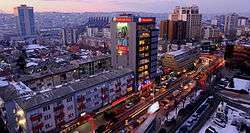
The majority Albanian population fled the town in large numbers to escape Serb policy and paramilitary units. The first NATO troops to enter Pristina in early June 1999 were Norwegian special forces from FSK Forsvarets Spesialkommando and soldiers from the British Special Air Service 22 S.A.S,[32][33] although to NATO's diplomatic embarrassment Russian troops arrived first at the airport. Apartments were occupied illegally and the Roma quarters behind the city park was torched. Several strategic targets in Pristina were attacked by NATO during the war, but serious physical damage appears to have largely been restricted to a few specific neighbourhoods shelled by Yugoslav security forces. At the end of the war, almost all of the city's 45,000 Serb inhabitants fled from Kosovo and today only several dozen remain within the city.[34]
As a capital city and seat of the UN administration (UNMIK), Pristina has benefited greatly from a high concentration of international staff with disposable income and international organizations with sizable budgets. The injection of reconstruction funds from donors, international organizations and the Albanian diaspora has fueled an unrivaled, yet short-lived, economic boom. A plethora of new cafes, restaurants and private businesses opened to cater for new (and international) demand with the beginning of a new era for Pristina.
Economy
The number of registered businesses in Pristina is currently at 8,725, with a total of 75,089 employees. The exact number of businesses is unknown because not all are registered. Since independence the Mayor of Pristina, Isa Mustafa has built many new roads in Pristina. Also he has plans to construct a ring road around the city.[35] The national government is taking part in modernising the roadways as well, building motorways to Ferizaj and other cities. An Albanian millionaire in Croatia is building the largest building in the Balkans with a projected height of up to 262 metres (860 ft) and capacity to hold 20,000 people. The cost for this is €400 million.[36] The Lakriste area is designated by Municipality as high-rise area with many complex building. The buildings such as ENK, World Trade Centre, Hysi and AXIS towers are being constructed in an area which previously served as an industrial zone.[37]
Turkey's Limak Holding and French firm Aéroport de Lyon won the concession tender for Pristina International Airport. Two companies pledged investment of €140 million by 2012.[38]
Commercial centers
Way before its declaration of independence in 2008, Kosovo and in particular its capital Pristina have been a big commerce center in the Balkans with a GDP of 4.0% in 2009.[39] Pristina beholds a variety of commercial centers. The best known commercial centres include Albi Mall, Migros, ELKOS - ETC, Viva Fresh Store, Maxi and Grandstore. Kosovo's economic activities are being supervised and supported by local and international chambers of commerce.
Tourism
Tourism in Pristina attracted 36,186 foreign visitors in 2012,[40] which represents 74.2%[41] of all visitors that visited Kosovo during that year. Foreign visitors mostly come from countries like Albania, Turkey, Germany, USA, Slovenia and Macedonia,[42] but also from other places. Some of the most visited places near Pristina are Batlava Lake and Gadime Marble Cave, which are also among the most visited places in Kosovo.[43]
Pristina is the primary tourist destination in Kosovo[44] and the main air gateway to Kosovo.[45] The number of foreign visitors that have visited Pristina during 2012 has grown for more than 10 thousand visitors, in comparison with year 2008, when there were 25,434 visitors.[46] During the first quarter of 2013 the number of hotels in Pristina was 24 from 102 hotels that were in total in Kosovo and during the third quarter of the year 2013, 18.85% of hotel capacity were used and during the same period of that year, in Pristina 423 rooms were with one bed, 268 rooms with two beds, 13 rooms with three beds, 49 apartments and 6 residents.[47]
Since 2009, Kosovo Tourism Association organizes annually a Tourism Fair in Pristina,[48] which is intended to attract foreign visitors to stay in Kosovo. In the International Tourism Fair held in Tokyo, Japan, in 2013, 4 day packages have been presented that a tourist from Asia can enjoy in Kosovo, starting from Pristina, then continuing in Peja, Gjakova and concluding in Prizren.[49]
Pristina is a place that is known as a university center of students[50] from regional countries like Albania, Macedonia, Montenegro, Serbia and more[51] and it represents a plateau of the combination of native, Ottoman and Yugoslav culture.[52] Its people are people that are known for hospitality[53][54][55] and religious tolerance,[56][57][58] where people in the city are mostly Muslims, but there are also Catholics, Orthodoxes, Atheists and people of other religions.[59] Around 23% of the people belong the group age of 16-27,[60] who are also very optimistic.[61]
Pristina has played a very important role during the World War II,[62] being a shelter for Jews, whose cemeteries now can be visited.[63][64]
Coffee bars are a representative icon of Pristina[52][65] and they can be found almost everywhere and are also centers of different festivals and events. In the region of Pristina there is Gračanica monastery, which is in the list of UNESCO World Heritage Sites.[66]
Sights
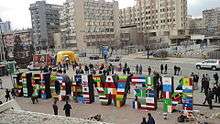
The Newborn monument was unveiled on 17 February 2008, the day that Kosovo declared its independence. It is decorated with the flags of the 99 nations which recognised its declaration.
The Grand Hotel Prishtina was the property of the Yugoslav government before the Kosovo War in 1999.
Kosovo Museum is located in an Austro-Hungarian-inspired building originally built for the regional administration of the Ottoman Vilayet of Kosovo. From 1945 until 1975 it served as headquarters for the Yugoslav National Army. In 1963 it was sold to the Kosovo Museum. From 1999 until 2002, the European Agency for Reconstruction had its main office in the museum building.
The Kosovo Museum has an extensive collection of archaeological and ethnological artifacts, including the Neolithic Goddess on the Throne terracotta, unearthed near Pristina in 1960[67] and depicted in the city's emblem. A large number of artifacts from antiquity are still in Belgrade, and the museum was looted in 1999.
The Clock Tower (Sahat Kulla) dates back to the 19th century. Following a fire, the tower has been reconstructed using bricks. The original bell was brought to Kosovo from Moldavia. It bore an inscription reading "this bell was made in 1764 for Jon Moldova Rumen." In 2001, the original bell was stolen. The same year, French KFOR troops replaced the old clock mechanism with an electric one. Due to Kosovo's electricity problems the tower is struggling to keep time.
Religious sites in the city include the Cathedral of Blessed Mother Teresa, a Roman Catholic church which was started in 2007. The Christ the Saviour Cathedral of the Serbian Orthodox Church was began in 1995 under the rule of Slobodan Milošević, and thus its existence remains controversial.[68][69]
Great Hamam of Pristina

The Great Hammam of Pristina (Albanian: Hamami i madh i Prishtinës, Turkish: Fatih Sultan Mehmet Han Hammam) is one of the few Ottoman era monuments in Pristina. Hamams are also known as Turkish baths. It was built in the 15th century and it was part of the Sultan Mehmet Fatih Mosque. During the months of summer and spring, it was used as a meeting place. Considered to be one of the most important buildings of the cultural and historical heritage, the great hamam of Pristina has been in a very bad condition through the years until its approval of restoration.[70] Nowadays, hamam is under restoration and it is planned to become the museum of Pristina.[71][72][73][74] The building of hamam is owned by the Municipality of Pristina and is under the protection of the Republic of Kosovo. It's part of the "List of cultural heritage" with the decision of the Minister Memli Krasniqi of the Ministry of Culture,Youth and Sport, since October 2012.[71][74] But,before that the Kosovo War, in 1985 the hamam was considered a protected monument by the law "Protection of the Monument" number 19/77,according to the architect Nol Binakaj.[75] According to him, even though the hamam is different a lot from the original version, only the east part of the building and the main face of the building have been changed. The rest of the building have remained the same.[75] The great hamam of Pristina is a symbol of the old Prishtina,together with the Clock Tower (Albanian: Sahat kulla), Çarshia Mosque (Albanian: Xhamia e Çarshisë), Academy building (Albanian: Ndërtesa e akademisë), Fatih Mosque (Albanian: Xhamia e mbretit) etc.[76]
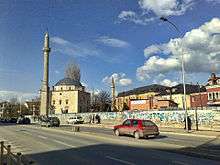
Germia Park
Germia is a regional park located in the north-east of Pristina, capital city of Kosovo, and it covers an area of 62 km2. This mountain massif is a part of the Rhodope Mountains, which lie from the Black Mountain of Skopje to Kopaonik mountains. Germia's highest point, Butos' Peak, is 1050 meters above sea level and its lowest is 663 meters above sea level.[77] Due to its geographical position and climate conditions, Germia mountain massif has a rich fauna with 63 species of animals and a variety of about 600 species of flora.[78] In 1987, the "Germia" complex was taken under protection by Pristina's Municipal Assembly in the category of the Regional Nature Park and is now managed by the publicly owned enterprise "Hortikultura". However, according to International Union for Conservation of Nature (IUCN), Germia should be designated as a protected landscape.
Ethnological Treasure of Kosovo
The Ethnological Treasure of Kosovo is an ethnographic museum in Pristina, Kosovo. It is located in Emin Gjiku Complex, a monument of culture from the 18th century. This house was once owned by the family of Emin Gjikolli. Emin Gjikolli nickname means "little man", in Turkish "Eminçik", which the complex holds the name today. In the museum, tools and items related to lifestyle from the Ottoman Kosovo period are on display.
In 2002, Ethnological Museum opened its exhibition of a permanent nature, in which ancient clothings, tools, container furniture and old weapons, etc. were presented.
Until 1990, the Emin Gjiku Complex served as a nature museum and after the completion of internationally funded conservation works in 2003, it was turned into an ethnological museum housing a vast collection of traditional costumes as well as utensils, handcraft elements and other tools used in everyday life. The above-mentioned collection is sheltered in the two central buildings of the complex (the house and the guest house) situated at the inner court, while at the entrance court, the relocated building is rented under a special contract by the museum to a Contemporary Art Centre 'Stacion' and the stable, the object of this study is left unused to date, even though the constant promises by the director of the museum to turn it into a traditional food restaurant.[79]
Kosova National Art Gallery
The Kosova National Art Gallery (Kosovar: Galeria Kombëtare e Arteve e Kosovës), is an art gallery situated at The University of Prishtina Campus (6), right behind the National Library of Kosova in Prishtina, Kosova, founded on February 1979.[80] It was named after one of the most prominent Kosovan artists of all time, Muslim Mulliqi.
It is the highest institution of visual arts in the country of Kosova. It is the space of various exhibitions of local and international artists. The most successful yearly exhibitions are the International Exhibition of Artistic Photography, "Gjon Milli"; the Young Artist Award, "Artists of Tomorrow"; and the International Exhibit Award, "Muslim Mulliqi".
The Kosovo Art Gallery has published many books, catalogues and brochures, among which are the monographies: "Kosovo Contemporary Art", and "Kosova Feniks".[81]
Historical monuments and locations
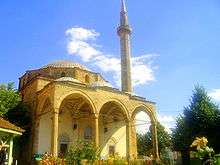
Historical monuments in Pristina are made up of 21 monuments out of a total of 426 protected monuments all over Kosovo.[82] A large number of these monuments date back to the Byzantine and Ottoman periods.[83]
Since 1945, the Yugoslav authorities followed the idea of constructing a modern Pristina by relying in the urban development motto “destroy the old, build the new”[84] and this resulted with major changes in the structure of the buildings, their function and their surrounding environment.[85] However, numerous types of monuments have been preserved, including four mosques, a restored orthodox church, an Ottoman bath, a public fountain, a clock tower, several traditional houses as well as European-influenced architecture buildings such as Kosovo Museum.[86] These symbolize the historical and cultural character of Pristina as it was developed throughout centuries in the spirit of conquering empires (Roman, Byzantine, Ottoman and Austro-Hungarian).[83]
Bazaar

The Bazaar of Pristina was the core merchandising center of the Old Pristina since the 15th century, when it was built.[87] It played a significant role in the physical, economic, and social development of Pristina. The Old Bazaar was destroyed during the 1950s and 1960s, following the modernization slogan of "Destroy the old, build the new". In its place, buildings of Kosovo Assembly, Municipality of Pristina, PTT, and Brotherhood and Unity socialist square were built. Nowadays, instead of PTT building resides the Government of Kosovo building. Only few historical buildings, such as the Bazaar Mosque and ruins of the Bazaar Hammam have remained from the Bazaar complex.[88] Since then, Pristina has lost part of its identity, and its cultural heritage has been scattered.
Culture
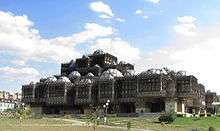
Pristina as the capital city of Kosovo is the center of cultural and artistic development of all Albanians that live in the Kosovo. The Department of cultural affairs is just one of the segments that arranges the cultural events, which make Pristina one of the cities with the most emphasized cultural and artistic traditions. The "Hivzi Sylejmani" library was founded 70 years ago and it is one of the largest libraries regarding the number of books in its inventory which is nearly 100.000. All of those books are in service for the library's registered readers.[89]
The "Mbretëresha e Dardanisë"(Queen of Dardania) or "Hyjnesha ne Fron"(The Goddess on the Throne) is an artifact that was found during some excavations in 1955[90] in the area of Ulpiana,[91] a suburb of Pristina. It dates back to 3500 BC in the Neolithic Era and it is made of clay.[92] In Pristina there is also "Hamami i Qytetit"(The City Bath) and the house of Emin Gjika which has been transformed to the Ethnographic Museum. Pristina also has its municipal archive which was established in the 1950s and holds all the records of the city, municipality and the region.[89]
Music
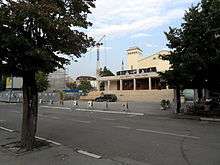
National Theatre, Pristina.
Theater
Pristina has only three active theatres: National Theater of Kosova, ODA Theatre and DODONA Theatre. They give live performances every week. There are 21 well-known Kosovan actors employed. They are placed in heart of Pristina. National Theatre (Teatri Kombetar) is placed in the middle downtown of the city, near the main government building.[93] ODA Theatre (Teatri ODA) is placed in the Youth Centre Building, and Dodona Theatre (Teatri Dodona) is placed in Vellusha district, which is near Ibrahim Rugova Square.
National Theater of Kosovo
The National Theater of Kosovo (in Albanian: Teatri Kombëtar) was founded in 1946 in the city of Prizren, Kosovo. It is the highest ranked theater institution in the country which has the largest number of productions. The National Theater is the only public theater in Kosovo and therefore it is financed by Ministry of Culture, Youth and Sport. This theater has produced more than 400 premieres which have been watched by more than 3 million spectators.[94]
Events and festivals
Chopin Piano Fest

Chopin Piano Fest Pristina is a festival established for the first time on the occasion of the 200th birth anniversary of Chopin in 2010, in Pristina by the Kosovo Chopin Association.[95]
The festival is the result of joined efforts of Dr. Lejla Pula-Haxhiu (Artistic Director) and Besa Luzha ( Secretary General and Festival Manager). Formed only to celebrate the 200th birth of Chopin, the festival was a great success and was greatly appreciated by the Kosovar audience.The festival continues to be organized annually, becoming a traditional piano festival held in spring every year.The festival is considered to be a national treasure.[96] In its 5 years of formation it has offered interpretations by both world-famous pianists such as Peter Donohoe,[97]Janina Fialkowska, Kosovar musicians of international renown like Ardita Statovci and Alberta Troni, and local talents.[96] The Festival strives to promote the art of interpretation, the proper value of music and the technicalities that accompany it.[96] The Festival has served as inspiration for the formation of other music festivals like Remusica and Kamerfest.[97]
Pristina Dam Festival
The International Festival of Young Musicians (DAM Festival Pristina) is one of the most prominent cultural events taking place in the capital city of the Republic of Kosovo, Pristina. Founded in 2006, DAM Festival is an annual music festival which gathers young and talented national and international musicians from all over the world. This festival works on enriching the Kosovar cultural scene with the collision of the traditional and the contemporary. DAM Fest was founded by back then art student, now well known TV producer, musician, journalist and manager of Kosovo's Philharmonic Orchestra, Dardan Selimaj.[98]
Fairs
Pristina had always a development in trading due to its position of the Balkan trade routes. Fairs in Pristina started since the medieval period, at the time when it was famous for its annual trade fairs and its goat hide and goat hair articles. Despite that fact Pristina, or Kosovo in general is not known for occurrence of fairs. With the development of culture and especially after the last war in 1999, Pristina had a progress on holding these kinds of events. Every year various types of trade fairs take place in the capital city. The essence of these fairs is usually temporary; some last only an afternoon while others may last around 3 days, a week or even longer. They have grown in size and importance over the years. These fairs are organized annually and are open to trade visitors and public. The number of exhibitors and visitors is usually very high.
Media
The media in Pristina include some of the most important newspapers, largest publishing houses and most prolific television studio of Kosovo .Pristina is the largest communications center of media in Kosovo. Almost all of the major media organizations in Kosovo are based in Pristina.[99]
The television industry developed in Pristina and is a significant employer in the city's economy. The four major broadcast networks, RTK, RTV21, KTV and KLAN KOSOVA, are all headquartered in Pristina . Radio Television of Kosovo (RTK) is the only public broadcaster both in Pristina and in all of Kosovo as well, who continues to be financed directly by the state.All of the daily newspapers in Pristina have a readership throughout Kosovo. [100]
An important event which affected the development of the media, is that in University of Pristina since 2005 is established the Journalism Faculty within the Faculty of Philology in which are registered a large number of youth people.[101]
Media in Pristina have followed all elections held in Kosovo,[102] especially a great impact was noted in Kosovo local elections, 2013,where media dedicated most of their time in political debates,advertisements and political parties programs.[103]
The freedom and pluralism of the media is guaranteed by the Constitution of Kosovo. Censorship is forbidden, except in the cases of provocation of violence and discrimination.[104] In according to organization Reporters Without Borders in 2013 Kosovo was ranked in the 85th place, after a year Kosovo made progress and was ranked in the 80th place.[105]
Environment
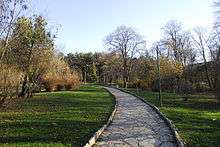
City Park was a badly managed, and was the only real green place in Pristina. Three markets (one of them very large) used to be a hotspot for dumping waste and other materials on the roads.
After the war of 1999, Pristina has changed dramatically. City Park has been fully changed. It now has stone pathways, tall trees, flowers have been planted and a public area has been built for children. The much larger Gërmia Park, located to the east of the city is the best place for a family to go and relax. Restaurants, small paths for people to have a run and a large outdoor swimming pool, basketball and volleyball court have been built for the pleasure of the citizens. Lately a new green place called Tauk Bashqe has been made halfway between Gërmia and City Park.
After the construction of the new Mother Teresa Square, many trees and flowers have been planted. This had a big impact on the city because of the trees releasing oxygen in the air. Many old buildings in front of the government building have been cleared to provide open space.
Education
Universities
National Library of Kosovo
The National Library of Kosovo (Albanian: Bibloteka Kombetare e Kosoves) is the highest library institution in Kosovo established by the Assembly, located in Pristina.
The mission of the National Library of Kosovo is to collect, preserve, promote and make accessible the documentary and intellectual heritage of Kosovo. The library holds exhibitions and holds an archive of Kosovar newspapers. It also provides a number of other services.
It is known for its unique history, and the style of the building designed by Croatian architect Andrija Mutnjaković followed by controversies about the outside appearance of it.
Sport
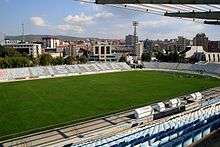
Football is the most popular sport in Pristina. Pristina is represented in the Football Superleague of Kosovo by KF Prishtina, which plays their home games in the City Stadium.
Basketball has been, since 2000, one of the most popular sports in Pristina. Pristina is represented in the Kosovo Basketball Superleague by Sigal Prishtina. Streetball Kosova is a traditionally organised sport and cultural event at the Germia Lake in Pristina since the year 2000.
Handball is also very popular. Pristina's representatives are recognised internationally and play international matches.
Demographics
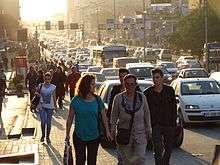
As of December 2012 Pristina had a population of 205,133 registered inhabitants[106]
The Rural Part of the municipality as well as the area near the center of Pristina, in terms of socio-economic processes is under the influence of population dynamics, both in terms of demographic regime, which is more expansive, and in addition mechanical population. This part of the municipality has a high density of population. According to some new data, the density of population in the municipality of Pristina is 247 inhabitants per km²[107] While the population density of suburban area of the municipality without Pristina, as an urban center, is 123 inhabitants per km²[108]
Pristina as an urban center with representative functions and its economic strength, has changed the population structure. Pristina with the surrounding space has become increasingly a concentration to a large population. While the mountain area, especially more distant areas have a displacement due to depopulation, especially after the recent war. The network of settlements on the territory of the Municipality of Pristina has some specifics. Such as distribution of settlements depends on the degree of economic development, natural conditions, socio-political circumstances, position. One of the features is also uneven distribution of the settlements.
Modern
According to the last census in 1991 (boycotted by the Albanian majority), the population of the Pristina municipality was 199,654, including 77.63% Albanians, 15.43% Serbs and Montenegrins, 1.72% Muslims by nationality, and others.[109] This census cannot be considered accurate as it is based on previous records and estimates.
In 2004 it was estimated that the population exceeded half a million, and that Kosovar Albanians form around 98% of it. The Serbian population in the city has fallen significantly since 1999, many of the city's Serbs having fled or been expelled following the end of the war. In early 1999 Pristina had about 230,000 inhabitants. There were more than 40,000 Serbs and about 6,500 Romas with the remainder being Albanians.
| Ethnic Composition, Including IDPs1 | |||||||||
| Year | Albanians | % | Serbs | % | Roma | % | Others2 | % | Total |
|---|---|---|---|---|---|---|---|---|---|
| 1991 census3 | 161,314 | 78.7 | 27,293 | 13.3 | 6,625 | 3.2 | 9,861 | 4.8 | 205,093 |
| 19984 | N/A | N/A | N/A | N/A | N/A | N/A | N/A | N/A | 225,388 |
| February 2000 estimate5 | 550,000 | 97.4 | 12,000 | 2.2 | 1,000 | 0.1 | 1,800 | 0.3 | 564,800 |
| Source: "OSCE Priština municipal profile" (PDF). (511 KB), June 2006, page 2 (Table 1.1). 1. IDP: Internally displaced person. | |||||||||
Contemporary Kosovo
| Pristina | Total | Ethnicity (2011 Census) | ||||||||||
|---|---|---|---|---|---|---|---|---|---|---|---|---|
| Albanian | Turks | Ashkali | Serbs | Bosnian | Gorani | Rom | Egyptian | Others | Prefer not
to Answer |
Not Available | ||
| Total[110] | 198,897 | 194,452 | 2,156 | 557 | 430 | 400 | 205 | 56 | 8 | 334 | 79 | 220 |
| Male | 99,361 | 97,347 | 1,060 | 281 | 204 | 107 | 99 | 31 | 3 | 110 | 37 | 82 |
| Female | 99,536 | 97,105 | 1,096 | 276 | 226 | 293 | 106 | 25 | 5 | 224 | 42 | 138 |
| Pristina | Total | Mother Tongue (2011 Census) | ||||||||||
|---|---|---|---|---|---|---|---|---|---|---|---|---|
| Albanian | Turkish | Serbian | Bosnian | Romani | Other | Not available | ||||||
| Total[110] | 198,897 | 195,093 | 2,065 | 490 | 393 | 66 | 524 | 266 | ||||
| Male | 99,361 | 97,646 | 1,019 | 227 | 114 | 35 | 210 | 110 | ||||
| Female | 99,536 | 97,447 | 1,046 | 263 | 279 | 31 | 314 | 156 | ||||
Religion
Kosovo does not have an official religion. Like the rest of the country, the majority of Pristina’s population consider themselves Muslim. Even though the majority of people are Muslim, not many attend mosques or religious services to the frequency in other Muslim countries. Many however do fast for Ramadan and praying is widely practiced.
The small minority of Pristina’s religious population that is not Muslim practices Christianity in the form of Roman Catholicism and Eastern Orthodoxy. When Pristina was in a Serbian empire, in the Middle Ages, Eastern Orthodoxy was a predominant faith other than Roman Catholicism.[111]
Politics
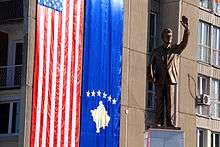
In the Preliminary results of the 2011 census the population of Pristina was numbered around 198,000.[112] The majority of population is Albanian, but there are also smaller communities including Bosniaks, Serbs, Romani and others. The surface of Pristina is 854 km². Pristina is known as the center of cultural, economical and political developments. Since 2014 the current Mayor is Shpend Ahmeti. The city is home of the Government Building and the Parliament of the Republic of Kosovo.
Transport
Pristina's transport forms the hub of road, rail and air networks in Kosovo. The city's buses, trains and planes together all serve to maintain a high level of connectivity between Pristina many different districts and beyond. Analysis of Traffic Police have shown that from 240.000 cars registered in Kosovo, around 100.000 cars or 41% of them are from the region of Pristina. Pristina railway station is located near the city centre.
Pristina International Airport

Pristina International Airport Adem Jashari (IATA: PRN, ICAO: BKPR) (Albanian: Aeroporti Ndërkombëtar i Prishtinës "Adem Jashari"; Serbian: Међународни аеродром Адем Јашари / Međunarodni aerodrom Adem Jašari) is an international airport located 15 km (9.3 mi) southwest[113] of Pristina, Kosovo.[114] It is an international airport that handles over 1.6 million passengers per year.[115] It is under the authority of the Republic of Kosovo and is the only port of entry for air travelers to Kosovo. Pristina International Airport is a secondary hub for Adria Airways of Slovenia. The airport is named after Adem Jashari, a former leader of the Kosovo Liberation Army.
Notable people

- Shpend Ahmeti, Current mayor of Pristina.
- Astrit Ajdarević. Swedish football player currently playing for Charlton Athletic.
- Visar Arifaj, Politician and leader of Partia e Fortë
- Xhavit Bajrami, Swiss kickboxer
- Besart Berisha, Albanian football player currently playing for Melbourne Victory.
- Etrit Berisha, Albanian football player currently playing for Lazio.
- Ilir Berisha, Albanian football player currently playing for Flamurtari Vlorë.
- Lorik Cana, Former Albanian footballer who last played for FC Nantes.
- Debatik Curri, Albanian football player currently playing for FC Prishtina.
- Armend Dallku, Albanian football player currently paying for Vorskla Poltava.
- Labinot Haliti, Australian football player currently playing for Western Sydney Wanderers
- Ahmet Haxhiu, Albanian political activist
- Albulena Haxhiu, Albanian politician
- Anđelko Karaferić, Serbian musician, Professor of Counterpoint and Associate Dean at the University of Pristina Faculty of Arts
- Jasmina Novokmet, Serbian conductor, Professor of Conducting and former Associate Dean at the University of Pristina Faculty of Arts
- Andrijana Videnović, Serbian actress and Associate Professor of Diction at the University of Pristina Faculty of Arts
- Albin Kurti, Political activist and leader of Vetëvendosje!
- Ermir Lenjani, Albanian football player currently playing for St. Gallen
- Xhevdet Llumnica, Kosovar football player currently playing for Limhamn Bunkeflo.
- Isa Mustafa, Politician, ex-mayor of Pristina.
- Jasmina Novokmet, Serbian conductor, Professor of Conducting and former Associate Dean at the University of Pristina Faculty of Arts.
- Atdhe Nuhiu, Austrian football player currently playing for Sheffield Wednesday.
- Rita Ora, singer-songwriter and actress
- Slobodan Petrović, politician and current Deputy Prime Minister of Kosovo
- Amir Rrahmani, footballer, who plays with Albania
- Petrit Selimi, current Deputy Minister of Foreign Affairs and leader of the Independent Liberal Party
- Rizah Sheqiri, author and poet
- Granit Xhaka, Swiss football player currently playing for Borussia Mönchengladbach.
- Taulant Xhaka, Swiss football player currently playing for Basel.
- Marko Simonović, Serbian basketball player, silver medalist at the 2016 Summer Olympics and 2014 FIBA World Cup
- Milena Rašić, Serbian volleyball player, European champion and Olympic silver medalist
- Dragan Tomić, former acting President of Serbia
International relations
Twin towns — Sister cities
|
Pristina is twinned with: |
See also
Notes
- 1 2 Kosovo is the subject of a territorial dispute between the Republic of Kosovo and the Republic of Serbia. The Republic of Kosovo unilaterally declared independence on 17 February 2008, but Serbia continues to claim it as part of its own sovereign territory. The two governments began to normalise relations in 2013, as part of the Brussels Agreement. Kosovo has received recognition as an independent state from 110 out of 193 United Nations member states.
References
- ↑ "Vlerësimi i popullësisë - Prishtina 2013" (PDF).
- ↑ "2011 Kosovo census: Urban statistics".
- ↑ "Define Pristina". Dictionary.com. Retrieved 28 October 2013.
- ↑ "Define Prishtina". Dictionary.com. Retrieved 28 October 2013.
- ↑ Official gov't census: http://esk.rks-gov.net/rekos2011/repository/docs/REKOS%20LEAFLET%20ALB%20FINAL.pdf
- ↑ SNOJ, Marko. 2007. Origjina e emrit të vendit Prishtinë. In: BOKSHI, Besim (ed.). Studime filologjike shqiptare: konferencë shkencore, 21–22 nëntor 2007. Prishtinë: Akademia e Shkencave dhe e Arteve e Kosovës, 2008, pp. 277–281.
- ↑ This etymology is mentioned in ROOM, Adrian: Placenames of the World, Second Edition, McFarland, 2006, page 304. ISBN 0-7864-2248-3
- ↑ "Monthly and annual means, maximum and minimum values of meteorological elements for the period 1961–1990" (in Serbian). Republic Hydrometeorological Service of Serbia. Retrieved 2012-09-08.
- 1 2 3 "Winter Drought Threatens Kosovo Capital's Water". Balkan Insight. Retrieved 2 March 2014.
- ↑ "ANNUAL PERFORMANCE REPORT OF WATER SERVICE PROVIDERS IN KOSOVO,IN 2012" (PDF). Water and Waste Regulatory Office. Retrieved 2 March 2014.
- ↑ Zogjani, Nektar (2014-01-08). "Uji Për Prishtinën Në Dorë Të Zotit". Gazeta Jeta në Kosovë. Retrieved 2 March 2014.
- 1 2 3 4 5 6 7 8 9 10 11 12 13 14 15 16 17 Warrander, Gail (2007). Kosovo: The Bradt Travel Guide. Bradt Travel Guides Ltd., 23 high street, chalfont st peter, bucks SL9 9QE, England: The Globe Pequot Press Inc. pp. 85–88. ISBN 1-84162-199-4. Retrieved 2013-05-18.
- ↑ Chapman 2000, p. 239
- ↑ , The Cambridge ancient history: The fourth century B.C. Volume 6 of The Cambridge ancient history, Iorwerth Eiddon Stephen Edwards, ISBN 0-521-85073-8, ISBN 978-0-521-85073-5, Authors: D. M. Lewis, John Boardman, Editors: D. M. Lewis, John Boardman, Edition 2, Publisher: Cambridge University Press, 1994 ISBN 0-521-23348-8, ISBN 978-0-521-23348-4.
- ↑ Adams, Douglas Q. (1997). James P. Mallory, ed. Encyclopedia of Indo-European Culture. Fitzroy Dearborn. ISBN 978-1-884964-98-5.
- ↑ Wilson, Nigel Guy (2006). Encyclopedia Of Ancient Greece. Taylor & Francis Group. ISBN 978-0-415-97334-2.
- ↑ Hauptstädte in Südosteuropa: Geschichte, Funktion, nationale Symbolkraft by Harald Heppner, p. 134
- 1 2 Archaeological Guide of Kosovo Ministry of Culture, Youth and Sport, Archaeological Institute of Kosovo, Pristina 2012
- ↑ Zadruga, Srpska Književna (1913). Izdanja. p. 265.
- ↑ Lekić, Đorđe (1995). Kosovo i metohija tokom vekova: Zublja. p. 22.
- ↑ Panić-Surep, Milorad (1965). Yugoslavia: Cultural Monuments of Serbia. p. 167.
- ↑ Vlahović, Petar (2004). Serbia: The country, people, life, customs. p. 392. ISBN 9788678910319.
- ↑ Bogdanović, Dimitrije (November 2000) [1984]. "Albanski pokreti 1908–1912.". In Antonije Isaković. Knjiga o Kosovu (in Serbian). 2. Belgrade: Serbian Academy of Sciences and Arts. Retrieved January 9, 2011.
... ustanici su uspeli da ... ovladaju celim kosovskim vilajetom do polovine avgusta 1912, što znači da su tada imali u svojim rukama Prištinu, Novi Pazar, Sjenicu pa čak i Skoplje ... U srednjoj i južnoj Albaniji ustanici su držali Permet, Leskoviku, Konicu, Elbasan, a u Makedoniji Debar ...
- ↑ Josef Redlich, Baron d'Estournelles, M. Justin Godart, Walter Shucking, Francis W. Hirst, H. N. Brailsford, Paul Milioukov, Samuel T. Dutton (1914). "Report of the International Commission to Inquire into the Causes and the Conduct of the Balkan Wars". Washington D.C.: Carnegie Endowment for International Piece. p. 47. Retrieved January 10, 2011.
This demonstration of Turkish weakness encouraged new allies, the more so that the promises of Albanian autonomy, covering the four vilayets of Macedonia and Old Servia, directly threatened the Christian nationalities with extermination.
- 1 2 3 4 Elsie, Robert (2010). Historical Dictionary of Kosovo. estover road plymouth PL6 7PY, United Kingdom: Scarecrow Press, Inc. pp. xxxiv. ISBN 978-0-8108-7231-8. Retrieved 2013-05-18.
- ↑ Murray 1999, p. 15.
- ↑ Sabrina P. Ramet The three Yugoslavias: state-building and legitimation, 1918–2005
- ↑ Fischer, Bernd Jürgen (1999). Albania at War, 1939–1945. West Lafayette, Indiana: Purdue Research Foundation. p. 187. ISBN 978-1-55753-141-4.
- ↑ Mojzes, Paul (2011). Balkan Genocides: Holocaust and Ethnic Cleansing in the 20th Century. Lanham, Maryland: Rowman & Littlefield. pp. 94–95. ISBN 978-1-4422-0665-6.
- ↑ "Kosovo Albanians 'driven into history'". BBC. April 1, 1999. Retrieved February 1, 2013.
- ↑ "Indictment against Milosevic and others". Americanradioworks.publicradio.org. Retrieved 2010-07-04.
- ↑ "Krigere og diplomater". norli.no. Retrieved 17 November 2015.
- ↑ "Tittel". norli.no. Retrieved 17 November 2015.
- ↑ "EuroNews Serbs in Kosovo vote in Gracanica and Mitrovica published February 3, 2008 accessed February 3, 2008". Euronews.net. Retrieved 2010-07-04.
- ↑ Komuna e Prishtinës: Investime të mëdha në infrastrukturë.
- ↑ Macedonia participates in large Kosovo investment.
- ↑ "Parkerad hos Webbhotell City Network". Retrieved 17 November 2015.
- ↑ Today's Zaman: Kosovo to open to world with Turkish-built airport, by Ali Aslan Kiliç, 14 August 2010, Saturday
- ↑ Monograph of the Kosovo Business 1921-2012. Kosova Chamber of Commerce. p. 165.
- ↑ "Hotel Statistics in Q3 2013 (Alb. Statistikat e hotelierisë TM3 2013)" (PDF). Kosovo Agency of Statistics. 2013. p. 9.
- ↑ "Kosovo Agency of Statistics, 'Hotel Statistics in Q3 2013'" (PDF). Kosovo Agency of Statistics. 2013. p. 9.
- ↑ "Kosovo Agency of Statistics, 'Statistikat e hotelierisë TM3 2013'" (PDF). Kosovo Agency of Statistics. 2013. p. 13.
- ↑ "12 thousand foreign tourists visited Kosovo (alb. 12 mijë turistë të huaj e vizituan Kosovën)". 2013.
- ↑ +Jugoslav Spasevski. "Kosovo". Tourist Destinations. Retrieved 17 November 2015.
- ↑ "Travellers' Guide To Kosovo - Wiki Travel Guide - Travellerspoint". Travellerspoint. Retrieved 17 November 2015.
- ↑ "Kosovo Agency of Statistics, 'Statistikat e hotelierisë TM3 2012'" (PDF). Kosovo Agency of Statistics. 2013. p. 13.
- ↑ "Kosovo Agency of Statistics, 'Statistikat e hotelierisë TM3 2012'" (PDF). KAS. 2013. p. 5.
- ↑ "Nesër hapet panairi i parë i turizmit në Kosovë (i plotësuar)". Retrieved 17 November 2015.
- ↑ Kosovo attends, for the first time, the International Tourism Fair in Tokyo, Japan
- ↑ "World city guide". Turkish Airlines. 2009. p. 104.
- ↑ "'University of Prishtina' 1970-2005". University of Prishtina. 2005. p. 33.
- 1 2 "Kosovo Travel Guide". Retrieved 17 November 2015.
- ↑ "Pristina in your pocket" (PDF). 2013. p. 9.
- ↑ "Kosovo: what to see in Europe's newest country". Telegraph.co.uk. Retrieved 17 November 2015.
- ↑ "7 Surprising Reasons to Visit Kosovo". Retrieved 17 November 2015.
- ↑ Wales Prince Charles interested about the religious tolerance in Kosovo (Alb. Princ Charles i Walesit interesohet për tolerancën fetare në Kosovë)
- ↑ Religious tolerance has always existed and exists in Kosovo (Alb. Toleranca fetare gjithnjë ka ekzistuar dhe ekziston në Kosovë)
- ↑ Dialog about the religious tolerance in Kosovo (Alb. Dialog mbi tolerancën fetare në Kosovë)
- ↑ "Demographic data about municipalities(Alb. Të dhënat demografike sipas komunave)" (PDF). 2013. p. 52.
- ↑ "Demographic data about municipalities(Alb. Të dhënat demografike sipas komunave)" (PDF). 2013. p. 18.
- ↑ Kosovars and Albanians, the happiest people in the region (Alb. Kosovarët dhe shqiptarët, popujt më të lumtur në rajon),
- ↑ The Virtual Jewish World - Kosovo
- ↑ "Kosovo's Jewish Cemetery Restored By University Students (PHOTOS)". The Huffington Post. Retrieved 17 November 2015.
- ↑ Material Culture and the history of the city of Prishtina (Alb. Kultura materiale dhe historia e qytetit të Prishtinës),
- ↑ "World city guide". Turkish Airlines. 2009. p. 104.
- ↑ UNESCO World Heritage Centre. "Medieval Monuments in Kosovo". Retrieved 17 November 2015.
- ↑ Thorpe, Nick (2007-06-04). "Kosovo contest for state symbols". BBC. Pristina. Retrieved 2008-02-21.
- ↑ "Albanian Intellectual: Demolish 'bad religion' Serbian Orthodox Temple". Britić. Retrieved 17 November 2015.
- ↑ "Kosovo Mulls Fate of Milosevic-era Cathedral". Retrieved 17 November 2015.
- ↑ sq:Monumentet kulturore në Prishtinë#Hamami i madh i Prishtin.C3.ABs
- 1 2 http://mem.rks-gov.net/repository/docs/Hamami_i_Vjeter_ne_Prishtine_shkurt_2013__502966.pdf
- ↑ "Gjashtë Vjet Punë Se Kthejnë Hamamin". Gazeta Jeta në Kosovë. Retrieved 17 November 2015.
- ↑ "Hamami i Prishtinës po restaurohet, shumë shkelje (video)". Retrieved 17 November 2015.
- 1 2 http://www.mkrs-ks.org/repository/docs/672.pdf
- 1 2 http://www.hdm.lth.se/fileadmin/hdm/alumni/papers/CMHB_2008_a/KOSOVO_Nol_Binakaj.pdf
- ↑ http://www.inyourpocket.com/kosovo/pristina/sightseeing/ottoman-pristina
- ↑ Pozicioni gjeografik i Germise. Prishtine. March 2014. p. 8.
- ↑ "Report on the state of nature" (PDF). UNDP. Retrieved 2 March 2014.
- ↑ Rozafa Basha (13 March 2008). "Proposal for Adaptation of the Emin Gjiku Stable Building in Prishtina" (PDF). Retrieved 2 March 2014.
- ↑ "Komuna Prishtine - Qyteti". kk.rks-gov.net. Retrieved 2014-03-02.
- ↑ "Galeria e Arteve e Kosovës | AKADEMIA EVOLUCION - Bachelor & Master". akademiaevolucion.com. Retrieved 2014-03-02.
- ↑ "Një e ardhme për të kaluarën e Pishtinës" (PDF) (in Albanian). Kosova Stability Initiative, European Stability Initiative. p. 9. Retrieved 23 February 2014.
- 1 2 Limani, Jeta. "Kulla of Mazrekaj family in Dranoc" (PDF). p. 2.
- ↑ Warrander, Gail; Verena Knaus. Kosovo. Bradt Travel Guides Ltd., UK. p. 3. ISBN 978 1 84162 331 3.
- ↑ "CONSERVATION BASIS FOR THE "HISTORIC CENTRE" OF PRISHTINË" (PDF) (in English, Albanian, and Serbian). December 2012. p. 3.
- ↑ "Conservation Basis for the "historic Centre" of Prishtinë" (PDF) (in English, Albanian, and Serbian). December 2012. p. 16.
- ↑ CHWB (2008). Heritage of Prishtina (PDF). Prishtinë: CHWB. p. 61.
- ↑ ESI (2014). "Foundations of the Old Hammam (listed since 1959)".
- 1 2 Letërnjoftim i shkurtër për kulturën e kryeqytetit Short notice of capital culture. Retrieved 25 February 2014.
- ↑ 'Tjerrtorja' Archaeological Site (listed since 1955). Retrieved 1 March 2014
- ↑ Goldsworthy, Adrian Keith; Haynes, Ian; Adams, Colin E. P. (1997). The Roman army as a community. Journal of Roman Archaeology. p. 100. ISBN 1887829342. Retrieved 2 March 2014.
- ↑ Idhulli i Dardanisë apo Hyjnesha në fron Dardanian idol or Goddess on the Throne. Retrieved 22 February 2014.
- ↑ "The National theatre of Kosovo".
- ↑ "Profili". Retrieved 17 November 2015.
- ↑ Luzha, Besa. "Chopin Piano Fest Prishtina". WordPress. Retrieved 2014-02-23.
- 1 2 3 Selmani, Arber. "'Chopin Fest' eshte pasuri shteterore". Retrieved 01/03/2014. Check date values in:
|access-date=(help) - 1 2 ""Chopin Piano Fest", në kujtim të Verdit". Koha Net. Retrieved 2014-02-23.
- ↑ "DAM Festival-KadMusArts".
- ↑ Kosovo Media Institute Major media organizations in Kosovo and their addresses.
- ↑ "OSCE". Retrieved 17 November 2015.
- ↑ "Fakulteti i Filologjisë - Ballina". Retrieved 17 November 2015.
- ↑ IREX Media sustainability in Kosovo,elections pg.2
- ↑ Monitorimi i sherbimeve mediale audio vizuele gjate fushates per zgjedhje lokale 2013 page 5-25.
- ↑ Constitution of Kosovo Article 42,Freedom of Media,pg.18
- ↑ "Reporters Without Borders". Retrieved 17 November 2015.
- ↑ "Vleresimi i popullsis 2012." (PDF). Kosovo Agency of Statistics (in Albanian). 31 December 2012. Retrieved 23 February 2014.
- ↑ "Density of Population.". Agency of State Archives of Kosovo (in Albanian). 3 August 2012. Retrieved 23 February 2014.
- ↑ Riza Qavolli ,"Gjeografia Regjionale e Kosoves page.157"
- ↑ Statistic data for the municipality of Priština – grad
- 1 2 "Results of the 2011 census" (PDF) (in Albanian). 31 March 2012. Retrieved 25 August 2014.
- ↑ "Religion in Kosovo". Retrieved 19 February 2014.
- ↑ "Agjencia e Statistikave të Kosovës - Â" (PDF). Retrieved 17 November 2015.
- ↑ "EAD Basic - Error Page". Retrieved 17 November 2015.
- ↑ Kosovo is the subject of a territorial dispute between the Republic of Kosovo and the Republic of Serbia. The Republic of Kosovo unilaterally declared independence on 17 February 2008, but Serbia continues to claim it as part of its own sovereign territory. The two governments began to normalise relations in 2013, as part of the Brussels Agreement. Kosovo has received recognition as an independent state from 110 out of 193 United Nations member states.
- ↑ (Civil Aviation Authority of the Republic of Kosovo)
- ↑ "Kardeş Kentleri Listesi ve 5 Mayıs Avrupa Günü Kutlaması [via WaybackMachine.com]" (in Turkish). Ankara Büyükşehir Belediyesi - Tüm Hakları Saklıdır. Archived from the original on 14 January 2009. Retrieved 2013-07-21.
- ↑ "Twinning Cities: International Relations" (PDF). Municipality of Tirana. www.tirana.gov.al. Retrieved 2009-06-23.
- ↑ Twinning Cities: International Relations. Municipality of Tirana. www.tirana.gov.al. Retrieved on 2008-01-25.
External links
| Wikimedia Commons has media related to Pristina. |
| Wikivoyage has a travel guide for Pristina. |
- Pristina In Your Pocket city guide
- University of Pristina
- Pristina Airport
- Pristina Bus Timetables and Maps
Coordinates: 42°40′N 21°10′E / 42.667°N 21.167°E
| | |||||||||
|---|---|---|---|---|---|---|---|---|---|
| Rank | Name | Districts | Pop. | Rank | Name | Districts | Pop. | ||
 Pristina Prizren |
1 | Pristina | Pristina | 210,722 | 11 | Glogovac (Drenas) | Pristina | 61,522 |  Ferizaj (Uroševac) 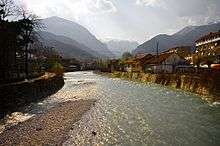 Peć |
| 2 | Prizren | Prizren | 186,860 | 12 | Lipljan | Pristina | 60,517 | ||
| 3 | Ferizaj (Uroševac) | Ferizaj (Uroševac) | 114,087 | 13 | Orahovac | Gjakova | 59,021 | ||
| 4 | Peć | Peć | 100,081 | 14 | Mališevo | Prizren | 58,198 | ||
| 5 | Gjakova | Gjakova | 98,240 | 15 | Skenderaj (Srbica) | Mitrovica | 52,951 | ||
| 6 | Gjilan | Gjilan | 93,291 | 16 | Vitina | Gjilan | 48,861 | ||
| 7 | Podujevo | Pristina | 91,642 | 17 | Deçan | Peć | 41,523 | ||
| 8 | Mitrovica | Mitrovica | 85,910 | 18 | Istok | Peć | 40,935 | ||
| 9 | Vučitrn | Mitrovica | 72,780 | 19 | Klina | Peć | 40,675 | ||
| 10 | Suva Reka | Prizren | 62,913 | 20 | Kosovo Polje (Fushë Kosova) | Pristina | 38,265 | ||
